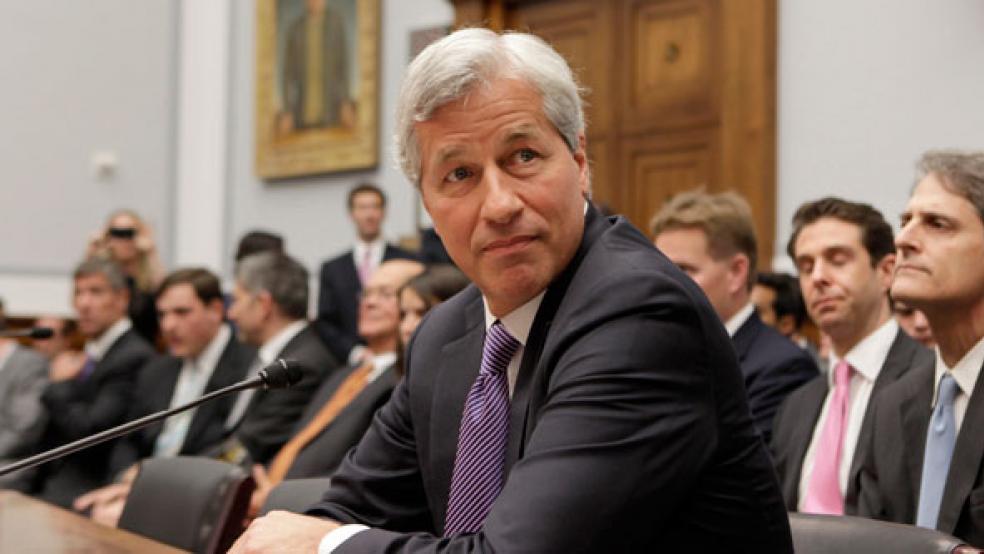When JPMorgan Chase (JPM) reports its second-quarter earnings on Friday, investors will finally get more details about the size of the trading loss incurred by the London Whale. But before that multi-billion-dollar goof returns to the spotlight, the bank already finds itself facing heat for another alleged misstep.

As The New York Times reported last week, JPMorgan’s team of financial advisers are being asked to steer their clients to invest in the bank’s own proprietary funds even when they’re more costly than those offered by other firms or their performance isn’t quite up to snuff.
It’s called cross-selling, and it’s a venerable tradition that ended up becoming the rationale behind the formation of the uber-banking institutions that now dominate the landscape. The rationale was – and remains, among those banks that still have a dedicated in-house asset management team – to more money from depositors by turning them into investors and consumers of insurance and any other financial-based product the bank could dream up.
RELATED: How to Find a Financial Adviser You Can Really Trust
Unsurprisingly, for nearly as long as these financial advisers (then still largely known as brokers) have been peddling in-house products, there has been controversy – and a countervailing push toward what has been dubbed “open architecture,” or making in-house funds available alongside best-of-breed funds offered by independent asset management firms. JPMorgan Chase, like every other bank, has had to recruit an entire team of ombudsmen to vet all those outside offerings and ensure there are no future Madoffs lurking amongst them.
To the extent that the bank’s managers put pressure on advisers to sell the bank’s proprietary funds to investors, shame on them. To the extent that those advisers complied – rather than following the now well-established trend of decamping to set up shop as an independent adviser – shame on them.
This is a different issue than the antics of Goldman Sachs (GS) with respect to the infamous Abacus deal. A banks’ asset management group is the one part of the business that is likely to have a genuine fiduciary relationship with clients. The common practice these days among financial advisers working for big institutions like JPMorgan Chase is to bend over backwards to disclose potential conflicts because regulators are taking a tougher view of an adviser’s duty of care toward clients.
In practice, that means that an adviser will tell a client, “Hey, I might invest your assets in bank-managed mutual funds if you give me discretion over your account.” An adviser who doesn’t disclose that is courting problems with regulators down the road, when a client complains of sub-par returns and excessive fees. (It’s unclear that The New York Times is suggesting that anything of that kind took place.)
Any high-net worth client working with JPMorgan or any other big bank – and yes, they are mostly very affluent folks with $1 million or more of investible assets, on average – who signs documents giving an adviser at a firm that isn’t fully independent (i.e., one that earns some of its revenues and profits by developing its own investment products) without reading the small print is ignoring a decade’s worth of debate over open architecture, an adviser’s duty to clients and a lot of common sense.
The case of funds is a more complicated one. These are crafted by advisers and their institutions as a way to get clients into hedge funds and other private investment partnerships that they otherwise couldn’t access, often because only an institution can command the resources to do so. (Even someone with a $10 million portfolio who is willing to invest a $1 million minimum in a hedge fund would be foolish to put 10 percent of his assets in a volatile fund of this kind; sometimes minimums are higher, and clients’ portfolios much smaller.)
This is the area in which open architecture doesn’t work as well – but again, the wealthy clients who entrust their assets to a JPMorgan adviser know, or should know, that this is an issue. They can ask to be consulted before their adviser commits to one of these private fund of funds; they can demand details of what fees are paid, to whom, and why.
The potential and actual conflicts of interest that exist with respect to an investment management division of a big financial firm are pretty apparent – and have been so for some time. That’s why there has been a battle royal over how a “fiduciary” is defined – big firms are, logically enough, fighting back against the idea they should be held to the same standard as independent advisers.
But investors – particularly the wealthy folks who make up the bulk of the banks’ clientele – are in a better position today than at any time in history. More of the top-tier advisers are choosing to work as independents, for precisely the reasons outlined by The Times, meaning that investors can get access to the same products and services as they could within a big bank. To the extent that clients opt to stay with JPMorgan – or Bank of America, or UBS – it’s easy for them to demand details of the funds that their adviser suggests to them, and to say “no” to a hard sell.
RELATED: Barclays and JPMorgan: When Big Banks Get Too Big
This isn’t the 1990s any more, when investors knew that to get an allocation of the latest hot IPO they needed to have a big investment account with one of the underwriters. (Well, it helps that there aren’t all that many hot IPOs any more, and the Facebook (FB) debacle has reminded us all of the problems of chasing them….)
To some extent, it is likely that clients keep part of their portfolios with JPMorgan, UBS and others because of the advantages of some other kinds of cross-selling. A top client of the firm’s wealth management division is going to get five-star service from other parts of the bank when they look for financing for their private plane, or a business loan tied to the purchase of a Chinese manufacturing enterprise, for instance.
To the extent that JPMorgan advisers have misled their clients, of course, that is another matter altogether. But so far, at least, there is no law that an adviser given discretionary authority over a client’s portfolio must completely avoid adding in-house products to the mix. In a perfect world, of course, no such conflicts would exist, and the banks would simply define asset management as investment counsel or advisory services, not the construction of funds. But in some cases that’s not possible – and unless or until regulators demand it, it’s unlikely that banks will move further in that direction than some already have done, particularly in the current environment, in which these revenues are far more stable than others the banks are generating.
So far, at least, there are no indications that there is massive malfeasance – simply that JPMorgan Chase, like other banks, is doing the same kind of business in the same kind of way that it has for a decade or more, generating the same kind of debate about “open architecture” that has taken place repeatedly over that time and that has made this particular kind of potential conflict one of the most visible and most frequently and readily understood.
If anything, the recent news about how different divisions of JPMorgan Chase dealt with the London Whale’s trading should reassure its clients that in one very important respect, conflicts don’t seem to exist at all. The most fearsome kind of potential conflict of interest exists when the bank’s top executives dictate to in-house money managers and advisers specific assets that they must buy and stuff in investors’ portfolios – think, subprime mortgage CDOs, or shares of Pets.com. In contrast, one of the bank-run investment funds took the other side of the Whale’s derivatives trade, generating hefty returns for its clients.
JPMorgan Chase is no paragon of virtue. The recent trading loss has revealed its risk management systems are flawed. Federal energy regulators are conducting an investigation into the bank’s power trading, and recently subpoenaed a series of e-mails connected to the matter. And, like all big banks, it’s going to put its own interests first whenever its bottom line is at stake. But the kinds of comments about a conflict of interest in the asset management division seem mostly to simply revive longstanding concerns that have been the target of independent advisers for well over a decade, rather than add fresh fuel to the fire.
Is it better for investors to work with an independent adviser? Sure, often. But even those independent advisers can have conflicts that may or may not be evident. Best of all is for investors to ask whomever they entrust with their portfolios to disclose and discuss potential conflicts. Among all a big bank’s clients, this is the group with the most rights – and the most options, if they feel they are being treated unfairly.






